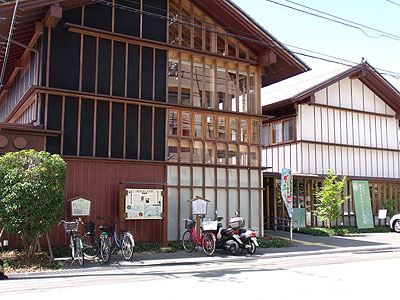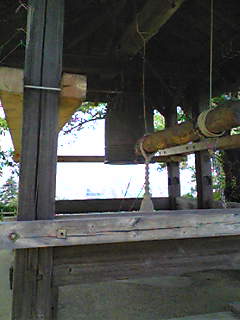June 28
One fine day during the rainy season, I visited the places
associated with Ryoma. The first place was Ryoma Memorial Museum at Kamimachi
in the city, which is only about 100 meters from our home. Believe it or
not, I hadn't entered this museum until then, in spite of its proximity
from home, probably because it is so close to our home that I thought I
could visit it anytime. In the museum there are displays to depict Ryoma's
childhood and achievements, all of which are easy to understand. The museum
is a Japanese-style building and it is said that interested persons who
loved and respected Ryoma donated roof tiles with their names written on
them. Ryoma's birthplace is within a stone's throw from this museum, only
2 minutes on foot. I am going to visit it before long.

Below is the photograph of Ryoma Memorial Museum.
June 25
One sunny day during the rainy season, I visited a memorable
place related to Comet Ikeya-Seki. The mountain in the distance in the
photograph is Konomori seen from Yokouchi in Kochi City.
I observed the comet immediately after it had passed perihelion
on October 22, 1965, first at Bandanomori and on the following day at this
Konomori. The public was invited to observe the comet with the help of
the mass media and a large number of residents participated in "mass
observation" of the comet.
Seventeen hours after perihelion we succeeded in observing
the comet at Bandanomori in Susaki City. Twenty-four hours later, we managed
to see the unaffected appearance of the comet at konomori, too. "Look,
it's there!", the cheers of the jubilant observers echoed all over
the place.
Mr. Koichi Ike, a mysterious "astronomy adventurer",
was always at the head of the crowd leading the fellow observers. He continued
to keep watch on the comet, more intensely than anybody else, when the
comet was approaching the sun extremely closely. He even built a mysterious
contraption "Ike projection box" and observed the comet near
the sun in this unusual method. Although he was not blessed with any comet
discovery, he made contributions to comet observation as a "silent
force behind the scenes". Where is our beloved friend Koichi Ike now?

The mountain in the distance is Konomori.
June 23
Rain has continued for two days followed by partly cloudy
skies. The sky was magnificently clear this morning.
I strolled along a walking track on the shore of Kagamigawa
River. Minor Planet 4256 is named after this river. The rocky area in the
lower left of the photograph was fondly called "Akaishi" (red
rocks) when I was a child. Ryoma Sakamoto is said to have enjoyed swimming
around there. When I was going to Daishi Elementary School(Minor Planet
21014 Daishi), there was no swimming pool at the school and we had to come
to this river to swim during physical education classes. We did races in
calm waters between turbulent areas. Unlike today, there were no dams built
upstream in those days and the river was deep with plenty of water running.
I remember the water was pure and cold, good enough for drinking. When
I was a junior high school student, B-29's carried out large scale air
raids over Kochi City. This was the river we fled to leaving the burning
home behind. I named a minor planet after this river hoping this beautiful
water is preserved forever.
The river looked especially beautiful today with lush green
leaves reflected on the water.

Kagamigawa River
June 10
At Sannomaru (the third compound of the castle) of Otakasakajyo
(Kochi Castle) there is a bell which has been long in sleep. After the
cannon used to announce "noon" was retired, this bell had been
used in its place and loved by the citizens as a time tone to announce
6 o'clock of the morning and evening for many years. Kochi was a small
city of population 180,000 in those days and the sound of the bell reached
through the tranquil air to every corner of the streets giving the residents
the feeling of relief as well as hope for tomorrow. The sound of the morning
bell was a spirited encouragement for people going to work and the evening
bell a soothing sound on their way home after a day's work.
I think it was in December, 1950. I was observing on the
rooftop of an abandoned factory near my home. I was immersed in the sense
of satisfaction having completed search of a beautiful and clear predawn
sky bathed in moonlight, though without any discovery. It was the most
satisfying and pleasant time for comet hunters even without a discovery.
With slowly brightening light of dawn, the sky took on a pale pink hue,
then the bell at the castle began to ring announcing 6 o'clock as if bidding
farewell to the stars disappearing one after another. The graceful sound
of the bell was carried throughout the city and spread to every corner
of my serene mind giving me great peace. The bell of Kochi Castle, which
rang in a brief moment between the awakening from the depth of night and
the beginning of bursting morning activity is still ringing in my ears.
I touched the bell gently. It held a history of more than
60 years. The coldness of the darkened surface of the bell brought to mind
a memory of freezing cold nights when I was desperately struggling for
comet discovery around 1950. The biggest problem was a battle against the
cold. Fruitless ten years had passed. And, in October 1961, after 11 years
of struggle, the first comet I discovered shone above the Tenshukaku (the
central tower of the castle). The sound of the bell I had always heard
after nightly observing was no longer there. I wish I had heard that familiar
sound of the bell in the excitement and emotion of this discovery.
When I came to Ninomaru (the second compound of the castle),
I came across an elderly man. He looked up at a tree branch high above
his head and murmured: "There is no sight of Konohazuku (a Japanese
scops owl). " I remember that decades ago the drum-like sounds of
owls were frequently heard as the night deepened. The sounds were heard
at my home 2 kilometers away just like the morning and evening bell. Nowadays,
the extremely high noise level of the city overwhelms faint sounds and
we have long lost the fascination of listening intently to feeble calls
of owls.

The Sannomaru Bell
June 9
Yodo Yamauchi, the last governor of Tosa, is thought to have
had some interest in the heavens. An astronomical telescope built by Germany's
Schneider Optics's was found in the storeroom of the Yamauchi family. Also
found were many armillary spheres, which are considered to have been built
by Keizan Kawatani, an Edo period astronomer. In the courtyard of Honmaru
(the central compound of the castle) an Edo period sundial is installed.
This is more like a device to tell the noon than a sundial. They determined
the timing of noon by watching the shadow of a wire stretched along the
meridian fall on the north-south groove etched on the stone.
At noon determined this way, they blasted a cannon once at
Sannomaru (the third compound), which reverberated throughout the city
and was endeared by the residents as the "boom" of noon. This
practice continued until around 1940, but this field cannon was procured
by the army at the outbreak of the battles in the Pacific in 1941. Since
then, the delightful sound of a bell has replaced the cannon and is heard
at 6 am and 6 pm everyday to please the ears of the residents.

The sundial
June 8Minor planet Otakasakajyo is born.
The photograph below is that of Otakasakajyo Castle, the
present day Kochi Castle. It was called Otakasakajyo when it was built
about 400 years ago.
Recently, the minor planet 1993 BL2 discovered at Geisei
Observatory has been named (26127) Otakasakajyo.
The first governor of the castle was Kazutoyo Yamauchi and
the castle has been loved by the citizens of Tosa (Kochi) to the present
day. Many tourists come to see the castle and Dr. B.G. Marsden of the Central
Bureau for Astronomical Telegrams visited there in 1987. The birthplace
of the famous Tosa warrior Ryoma Sakamoto is located in the castle town
of Kochi not far from the castle itself.

Otakasakajyo Castle






